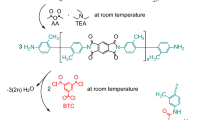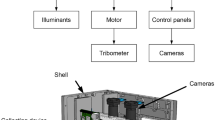Abstract
Eight pin-on-disk tribometers have been made for testing materials in space on board the International Space Station. They will be exposed directly to the low earth orbit (LEO) environment on board the “Materials on the International Space Station Experiments” platform where they will experience extreme conditions including atomic oxygen, ultrahigh vacuum, radiation (including UV radiation), and thermal ranges from −40 to 60 °C. In order to survive launch and LEO, these tribometers were designed to be extremely compact, rugged, and reliable. Pin-on-disk tribology experiments are now being performed with a 13.2 mm/s sliding velocity (14 RPM at 9 mm wear track radius) and a 1 N normal load with hemispherical pin of 1.5875 mm radius. Materials tested include MoS2/Sb2O3/Au, MoS2/Sb2O3/C, YSZ/Au/MoS2/DLC, and SiO-doped DLC coatings, and bulk samples of polytetrafluoroethylene (PTFE) alumina nanocomposites and gold.



Similar content being viewed by others
References
Yang, J.C., De Groh, K.K.: Materials issues in the space environment. Mrs Bull. 35, 12–16 (2010)
Edwards, D.L., Tighe, A.P., Eesbeek, M.V., Kimoto, Y., De Groh, K.K.: Overview of the natural space environment and ESA, JAXA, and NASA materials flight experiments. Mrs Bull. 35, 25–34 (2010)
De Groh, K.K., Banks, B.A., McCarthy, C.E., Rucker, R.N., Roberts, L.M., Berger, L.A.: MISSE 2 peace polymers atomic oxygen erosion experiment on the international space station. High Perform Polym. 20, 388–409 (2008)
Dever, J.A., Miller, S.K., Sechkar, E.A., Wittberg, T.N.: Space environment exposure of polymer films on the materials international space station experiment: Results from MISSE 1 and MISSE 2. High Perform Polym. 20, 371–387 (2008)
Walters, R.J., Garner, J.C., Lam, S.N., Vasquez, J.A., Braun, W.R., Ruth, R.E., Messenger, S.R., Lorentzen, J.R., Bruninga, R., Jenkins, P.P., Flatico, J.M., Wilt, D.M., Piszczor, M.F., Greer, L.C., Krasowski, M.J.: Materials on the international space station - forward technology solar cell experiment. Mat. Sci. Eng. B-Solid. 116, 257–263 (2005)
Jenkins, P.P., Walters, J.R., Michael, J.K., John, J.C., Perry, G.B., John, A.V., Denis, R.M., Susie, N.L., William, R.B., Robert, S., Norman, F.P., Joseph, M.F., Lawrence, C.G., Karen, B.G., William, H.K., and Pippin, H.G.: MISSE 7: building a permanent environmental testbed for the international space station. AIP,(2009)
Sawyer, W.G., Wahl, K.J.: Accessing inaccessible interfaces: In situ approaches to materials tribology. Mrs Bull. 33, 1145–1148 (2008)
Wahl, K.J., Sawyer, W.G.: Observing interfacial sliding processes in solid-solid contacts. Mrs Bull. 33, 1159–1167 (2008)
Banks, B.A., Miller, S.K., de Groh, K.K.: Low earth orbital atomic oxygen interactions with materials. In: Second International Energy Conversion Engineering Conference. Providence, Rhode Island (2004)
Grossman, E., Gouzman, I.: Space environment effects on polymers in low earth orbit. Nucl. Instrum. Meth. B. 208, 48–57 (2003)
ASTM: Standard solar constant and zero air mass solar spectral irradiance tables. ASTM E490 (2006)
ASTM: Standard tables for reference solar spectral irradiances: Direct normal and hemispherical on 37° tilted surface. ASTM G173 - 03e1)
Dever, J.A.: Low earth orbital atomic oxygen and ultraviolet radiation effects on polymers. E-5943; NAS 1.15:103711; NASA-TM-103711 (1991)
Miles, J.W.: On structural fatigue under random loading. J. Aeronaut. Sci. 21, 753–762 (1954)
Burris, D.L., Sawyer, W.G.: Improved wear resistance in alumina-PTFE nanocomposites with irregular shaped nanoparticles. Wear 260, 915–918 (2006)
Mcelwain, S.E., Blanchet, T.A., Schadler, L.S., Sawyer, W.G.: Effect of particle size on the wear resistance of alumina-filled PTFE micro- and nanocomposites. Tribol. T. 51, 247–253 (2008)
Aouadi, S.M., Paudel, Y., Luster, B., Stadler, S., Kohli, P., Muratore, C., Hager, C., Voevodin, A.A.: Adaptive Mo2N/MoS2/Ag tribological nanocomposite coatings for aerospace applications. Tribol. Lett. 29, 95–103 (2008)
Martin, J.M., Le.Mogne, T., Boehm, M., Grossiord, C.: Tribochemistry in the analytical UHV tribometer. Tribol. Int. 32, 617–626 (1999)
Muratore, C., Voevodin, A.A.: Molybdenum disulfide as a lubricant and catalyst in adaptive nanocomposite coatings. Surf. Coat. Tech. 201, 4125–4130 (2006)
Roberts, E.W.: Ultralow friction films of MoS2 for space applications. Thin Solid Films 181, 461–473 (1989)
Scharf, T.W., Kotula, P.G., Prasad, S.V.: Friction and wear mechanisms in MoS2/Sb2O3/Au nanocomposite coatings. Acta Mater. 58, 4100–4109 (2010)
Tagawa, M., Muromoto, M., Hachiue, S., Yokota, K., Ohmae, N., Matsumoto, K., Suzuki, M.: Hyperthermal atomic oxygen interaction with MoS2 lubricants and relevance to space environmental effects in low earth orbit - effects on friction coefficient and wear-life. Tribol. Lett. 18, 437–443 (2005)
Voevodin, A.A., Zabinski, J.S.: Nanocomposite and nanostructured tribological materials for space applications. Compos. Sci. Technol. 65, 741–748 (2005)
Zabinski, J.S., Bultman, J.E., Sanders, J.H., Hu, J.J.: Multi-environmental lubrication performance and lubrication mechanism of MoS2/Sb2O3/C composite films. Tribol. Lett. 23, 155–163 (2006)
Fleischauer, P.D., Hilton, M.R., Raju, B.K., Vedachalam, N., Wei, L.Y., Huang, K.W., Nishimura, M.: International applications of space tribology. Tribol. Int. 23, 135–147 (1990)
Hamilton, M.A., Alvarez, L.A., Mauntler, N.A., Argibay, N., Colbert, R., Burris, D.L., Muratore, C., Voevodin, A.A., Perry, S.S., Sawyer, W.G.: A possible link between macroscopic wear and temperature dependent friction behaviors of MoS2 coatings. Tribol. Lett. 32, 91–98 (2008)
Voevodin, A.A., Fitz, T.A., Hu, J.J., Zabinski, J.S.: Nanocomposite tribological coatings with “Chameleon” Surface adaptation. J. Vac. Sci. Technol. A. 20, 1434–1444 (2002)
Baker, C.C., Chromik, R.R., Wahl, K.J., Hu, J.J., Voevodin, A.A.: Preparation of chameleon coatings for space and ambient environments. Thin Solid Films 515, 6737–6743 (2007)
Chromik, R.R., Baker, C.C., Voevodin, A.A., Wahl, K.J.: In situ tribometry of solid lubricant nanocomposite coatings. Wear 262, 1239–1252 (2007)
Erdemir, A., Donnet, C.: Tribology of diamond-like carbon films: Recent progress and future prospects. J. Phys. D Appl. Phys. 39, R311–327 (2006)
Bhaskaran, H., Gotsmann, B., Sebastian, A., Drechsler, U., Lantz, M.A., Despont, M., Jaroenapibal, P., Carpick, R.W., Chen, Y., Sridharan, K.: Ultralow nanoscale wear through atom-by-atom attrition in silicon-containing diamond-like carbon. Nat. Nanotechnol. 5, 181–185 (2010)
Bares, J.A., Sumant, A.V., Grierson, D.S., Carpick, R.W., Sridharan, K.: Small amplitude reciprocating wear performance of diamond-like carbon films: Dependence of film composition and counterface material. Tribol. Lett. 27, 79–88 (2007)
[33].Scharf, T.W., Ohlhausen, J.A., Tallant, D.R., and Prasad, S.V.: Mechanisms of friction in diamondlike nanocomposite coatings. J. Appl. Phys. 101 (2007)
Prasad, S.V.: Personal communication. (2009)
Burris, D.L., Sawyer, W.G.: Addressing practical challenges of low friction coefficient measurements. Tribol. Lett. 35, 17–23 (2009)
Schmitz, T.L., Action, J.E., Ziegert, J.C., Sawyer, W.G.: The difficulty of measuring low friction: Uncertainty analysis for friction coefficient measurements. J. Tribol.-T Asme. 127, 673–678 (2005)
Gao, F., Erdemir, A., Tysoe, W.T.: The tribological properties of low-friction hydrogenated diamond-like carbon measured in ultrahigh vacuum. Tribol. Lett. 20, 221–227 (2005)
Kim, H.I., Lince, J.R., Eryilmaz, O.L., Erdemir, A.: Environmental effects on the friction of hydrogenated dlc films. Tribol. Lett. 21, 53–58 (2006)
Martin, J.M., LeMogne, T.: Tribo-oxidation in UHV experiments. Analusis. 25, M28–30 (1997)
Singer, I.L., LeMogne, T., Donnet, C., Martin, J.M.: Friction behavior and wear analysis of sic sliding against Mo in SO2, O2 and H2S at gas pressures between 4 and 40 pa. Tribol. T. 39, 950–956 (1996)
Acknowledgments
This project, designed, developed, and eventually delivered tribometers to the International Space Station. This could not be possible without significant collaborations and support from the research community. Significant thanks are owed to: John Jones, Michelle Ewy, Andrey Voevodin, Shane Juhl, Chris Muratore, Justin Lenoff, Jeffrey Zabinski, and Andy Korenyi-Both, Gary Pippin, Andy Robb, Many Urcia, Miria Finckenor, Phillip Jenkins, David Burris, Robert Carpick, Andy Konicek, Somuri Prasad, Chandra Venkatraman, Jim Keith, Rachel Colbert, Jennifer Vail, Nick Argibay, Jason Steffens, Dan Dickrell, Scott Perry, Linda Schadler, Thierry Blanchet, and Joe Priester.
Author information
Authors and Affiliations
Corresponding author
Appendix 1: Uncertainty Analysis for the Space Tribometers
Appendix 1: Uncertainty Analysis for the Space Tribometers
The uncertainty analysis for the friction coefficient follows the methods described by Burris and Sawyer [35] and Schmitz et al. [36]. To a reasonable approximation the uncertainty in the lateral directions is the same as the uncertainty in the normal direction, u(F L) = u(F N) = u(F). In addition, the magnitude of the lateral forces during clockwise and counterclockwise rotations are approximately equal, \( \left| {F_{{\rm L_{\rm cw} }} } \right| = \left| {F_{{\rm L_{\rm ccw} }} } \right| = \left| {F_{L} } \right| \). Hence,
Upon simplification, and a substitution for the lateral force magnitude (F L = μF N), Eq. 2 can be simplified to give Eq. 3:
Solving for uncertainty in the average friction coefficient is compactly given by Eq. 4. For low-friction materials, the uncertainty in friction coefficient is given by Eq. 5.
For the experimental design and instrumentation used on this tribometer embodiment, the uncertainty in forces was u(F) = 15 mN, and the normal load was nominally F N = 1 N. Thus, the uncertainty in friction coefficient is not better than u(μ) = 0.01. This is a reasonable result and achievement considering design constraints placed on the hardware, but, as others have demonstrated in UHV, it is certainly possible to have lower uncertainties in friction coefficient [18, 37–40].
Rights and permissions
About this article
Cite this article
Krick, B.A., Sawyer, W.G. Space Tribometers: Design for Exposed Experiments on Orbit. Tribol Lett 41, 303–311 (2011). https://doi.org/10.1007/s11249-010-9689-y
Received:
Accepted:
Published:
Issue Date:
DOI: https://doi.org/10.1007/s11249-010-9689-y




